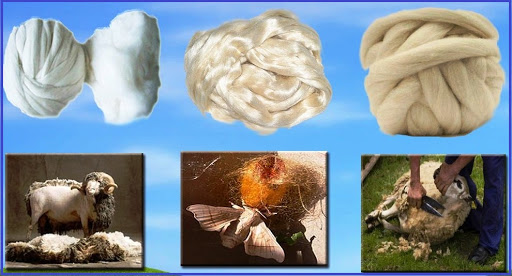Textile Raw Materials/ TRM / Types of Textile Fibers
Raw material plays an important role in any industry. In textiles, Fibers are the basic raw material which later become end product that is Garment
Introduction
to Fibers
Word Fiber originated from the Latin word Fibra. Fibers are the small heir like tissues, obtained from animals, plants, or other sources which are small in length. Fibers can be natural or manmade.
Textile fiber
classification
Fibers are classified into two main categories,
· Natural Fibers
· Man-Made Fibers
Natural
Fibers
Natural Fibers are the fibers taken from organic sources like Animals, and Plants
Natural fibers are of three types.
·
Vegetable origin
·
Mineral origin
·
Animal
origin
Vegetable
Origin
Vegetable Fibers composed of cellulose,
which is made up of sugar and starch. Fibers in form of bundles are held
together with the help of natural resins and gums that are present in different
parts of plants like leaves, stem, etc. Vegetable fibers can be divided into the following categories.
·
Stem Fibers- also
known as bast fibers and taken from the inner side of the bark
·
Leaves
Fibers-extracted from leaves-present in lengthwise
·
Fruits and seeds
fibers-Comprises of the hairs from seeds and flosses
Examples of vegetable fibers:
Roselle, Cotton, Hemp, Jute, Flax, Abaca, Piña, Ramie, Sisal, Bagasse, and Banana.
Animal origin
7% of the total textile fibers consist of
animal fibers. Despite their limited production, they have a vital role in
textiles.
Major Animal fibers are as follow:
Wool Fibers
and hair fibers,
Fibers extracted from animals having fur,
these fibers are widely used as textile fibers. Wool fibers are mainly known
for sheep extracted. All the hair and wool fibers are formed of keratin so their
chemical structure is related, but they exhibit different physical
characteristics such as length, shapes, and fineness.
Silk Fibers
Fiber took from the cocoon of the silkworm. The
production of silk in all the textile fibers is very low i.e. 0.25% of the total
textile fibers. Despite this fact, it is a very important textile fiber and
it is expensive when compared with other textile fibers.
Mineral
fibers
The natural fiber that falls in the
category of minerals is asbestos. It is a set of silicate minerals that are
present naturally. It is one of the strongest fibers that are found naturally. Asbestos
is used as fiber since ancient times
Man-Made
Fibers
Natural fibers cannot fulfill the demand
of world textiles, that’s why using advance technology human has made fibers. We
can produce long-chain molecules from very simpler chemicals. By using this
technique, we have learned to produce polyester and nylon.
Types of Man-Made Fibers
·
Regenerated Fibers
·
Synthetic fibers
Regenerated
Fibers
Regenerated Fibers are also known as
Natural polymer fibers, in which fiber-forming substance is taken from a natural
source. Regenerated fibers are sub-categorized as follow:
·
Cellulose fibers
·
Cellulose ester
fibers
·
Protein fibers
·
Miscellaneous
natural polymer fibers
Synthetic
Fibers
The synthetic fibers are sub-categorized
according to their chemical structure. Some of the commercially important
synthetic fibers are as followed;
·
Polyesters
·
Polyamides
·
Polyvinyl
·
Polyurethanes










No comments:
Post a Comment